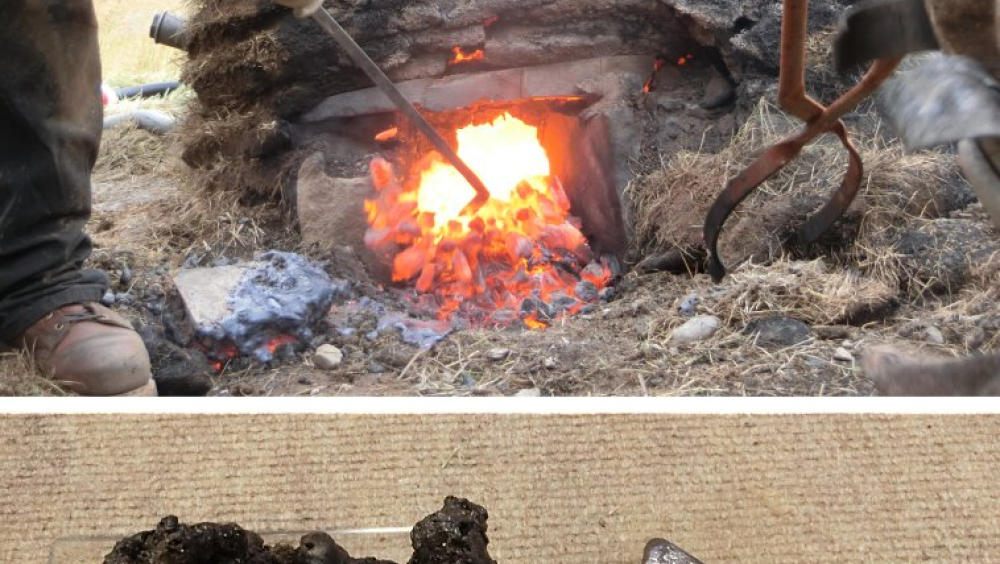Iron making during the Viking period Iceland - lost heritage rediscovered
A group of common nerds and specialists, including archaeologists, has been trying to rediscover how the iron-making skills of Viking period Europe were translated to a new and geologically different territory in Viking time Iceland. It is a mystery for the reason that in Iceland, no useful minerals can be found, that was identical to the clay that was the main building material in European iron age furnaces. The group decided to form a festival, homage to experimental archaeology, where they could try out their theories, with the participation of common visitors. And there could be no better place to do that in Iceland, than Eiriksstadir; the birthplace of Leif Eiriksson, where a longhouse stands, the exact replica based on a 10th-century ruin of the house of Erik the Red. The site is a representation of experimental archaeology to the core, being built by archaeologists, teamed up with modern architects and skilled craftsmen. This perfect location attracted many guests, who enjoyed taking part in making the first iron in Iceland for at least 700 years.
For some years, a group of people from several countries has been trying to rediscover the ancient secrets of iron making in Iceland during the Viking Era. Although Iceland holds vast resources of written material dating back to the Viking Era, none of the writers of that material seems to have bothered to describe such a mundane procedure as producing iron. The rest of the Viking society in Europe had access to good quality clay, that could withstand the high temperatures needed to make iron from bog material. It is obvious from archaeological findings in Iceland, that for the first century of settlement in Iceland, people were struggling and failing because the soil in Iceland is totally different from the European continent. After that they were successful and produced a lot of iron, so obviously they found a way to wor with the materials available in Iceland. So this group, consisting of Icelanders and an American group called Hurstwic, set out to find the missing link. Engineers, chemists, archaeologists, historians, glass-makers, ceramists....all kinds of people were involved in the think tank, trying to find a solution. In early 2019 we had some good theories about the missing link; materials that could be used to strengthen the local clay. A date was set for a festival, aimed at involving the common Icelander in the process of rediscovering this ancient wisdom. The festival was held in late August. The main activities were building and firing iron-making furnaces and firing them, but also inviting specialists to tell the guests about smelting, weapon-making and the general life of the 10th-century Icelander. Guests could participate in the process: Blow the bellows, hit the red-hot iron, peek into the furnaces, try out the weapons and cook the way a Viking would. The heart of the festival was the involvement of guests in all activities. And they enjoyed it! People were mesmerized by the fire, by the noise of the blacksmith's hammers and eager to try out the spears that were there for testing. In the evenings there were lectures from specialists: Dr. Mikko Moilanen, a Finnish renowned scolar, told the guests about sword making in Viking Scandinavia, Margrét Hrönn Hallmundsdóttir, a well-known archaeologist in Iceland told of her researches on iron-making sites in Iceland, dr. William Short talked about Viking combat techniques and blacksmith Emilliano Carrillo described the process of using bloom iron for making a multi-layered Viking style sax. There were hundreds of guests in Eiriksstadir during the festival, even with Eiriksstadir being situated in remote rural Iceland. Many of the guests came day after day, looking forward to seeing if the experiments would be successful or not. And they were. An idea coming from a local ceramist, about adding horse-manure ashes to the clay mixture seemed to do the trick. The ash, containing a lot of silica, seemed to raise the melting point of the local lava-rich clay enough for it to tolerate the 1300°C degrees needed. This festival was suddenly news-worthy. Showing a possible missing link, that scholars have been pondering for decades, with the participation of the general public and the input of all kinds of nerds from all over. Perhaps the answer to the secret lies in burned horse poop!
The iron-age was a major turning point in European history, the ground for great technical development and development of societies. Slowly Vikings rose as a civilization in northern Europe, basing their technology on working with iron and wood. Without iron, no Viking ships would have been built and no new lands discovered. In the 9th century Vikings came to Iceland. A volcanic desert island in the middle of the Atlantic ocean. They brought their skills with them but failing to use the conventional methods of Iron-making in this strange new land for the first century. Although Icelandic literature carries a lot of information on Vikings all over Europe and records their travels to other continents, somehow many mundane details have not been documented. Iron-making is one of these mundane details. After the iron-making festival in Iceland 2019, we may know a little bit more about this skill and about the innovative mindset of the Viking culture, which seems to have found the answer.
